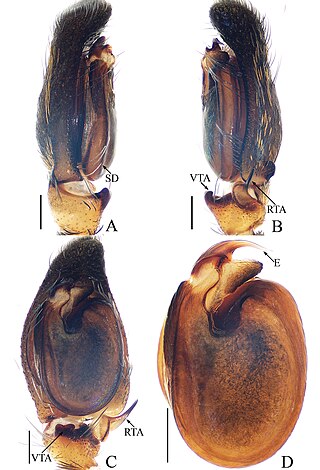
Chrysilla is a genus of jumping spiders that was first described by Tamerlan Thorell in 1887. Several species formerly placed here were transferred to Phintella, and vice versa. Females are 3 to 4 millimetres long, and males are 4 to 9 millimetres long. The genus is Persian, derived from the Greek Χρύσιλλα.

Epocilla is a genus of jumping spiders that was first described by Tamerlan Thorell in 1887. The name comes from Ἐπόκιλλος (Epocillus), a soldier of Alexander the Great.
Wesolowskana is a spider genus of the family Salticidae. Both described species are endemic to the Cape Verde Islands. The genus should possibly be included in the genus Pseudicius. It was originally named Luxuria when it was first described by Wanda Wesołowska in 1989. It was renamed in 2008 because Luxuria was already in use for a genus of molluscs. This genus was named in honour of Wanda Wesołowska.

Nicylla is a monotypic genus of Sumatran jumping spiders containing the single species, Nicylla sundevalli. It was first described by Tamerlan Thorell in 1890, and is only found on Sumatra. Briefly considered a synonym of Thiania, it was elevated back to genus status in 2017.

Omoedus is a genus of jumping spiders.

Simaetha is a genus of Australasian jumping spiders that was first described by Tamerlan Thorell in 1881. They resemble members of Simaethula and Stertinius.

Gelotia is a genus of jumping spiders that was first described by Tamerlan Thorell in 1890.
Troglohyphantes vignai is a species of cave spider of the family Linyphiidae. It is endemic to Italy.
Domitius menozzii is an araneomorph spider species of the family Nesticidae. It occurs in Italy, where it can be found in caves. It was described by Ludovico di Caporiacco in 1934.
Helvidia is a monotypic genus of Sumatran comb-footed spiders containing the single species, Helvidia scabricula. It was first described by Tamerlan Thorell in 1890, and is found on Sumatra. Only males have ever been recorded.
Belippo anguina is an endemic jumping spider species that lives in São Tomé and Príncipe. It was first identified in 1910 by Simon from a juvenile specimen and is the type species for the genus Belippo. Its female holotype measures 4 mm.
Orcevia is a genus of Asian jumping spiders first described by Tamerlan Thorell in 1890. Laufeia, circumscribed to include Orcevia, is placed in the tribe Euophryini in the Salticoida clade of Salticinae. It was once considered a synonym of Laufeia, but it was revalidated in 2019.
Heteropoda sumatrana is a species of spiders in the genus Heteropoda, family Sparassidae, found in Indonesia. It was first described by Thorell in 1890.
Aphantaulax ensifera is a species of ground spiders native to São Tomé and Príncipe. The species was named by Eugène Simon in 1907.
Talaus elegans is a species of crab spiders in the family Thomisidae. It is found in Sumatra.
Maltecora janthina is an endemic jumping spider species of the family Salticidae that lives on São Tomé Island. It was first named in 1910 by Eugène Simon.
Hogna thetis is an endemic spider species of the family Lycosidae that lives on Príncipe in São Tomé and Príncipe. It was first described as Lycosa thetis in 1907 by Eugène Simon.
Pochyta insulana is an endemic jumping spider species of the family Salticidae that lives on the island of Príncipe, São Tomé and Príncipe. It was first named and described in 1910 by Eugène Simon.

Cosmophasis lami, also known as the Lami Beach northern jumping spider or tangerine garden jumper, is a species of jumping spider in the genus Cosmophasis, probably native to South East Asia and some pacific islands, and possibly introduced to Japan and Okinawa Islands by humans. It was first described by Berry, Beatty & Prószynski in 1997 and has one synonym, Cosmophasis squamata (Saaristo,2002) Both the female and the male have been described.
Odontodrassus aphanes is a species of ground spider native to East Asia and Oceania, ranging from Myanmar to Japan. It has been introduced to Jamaica.








